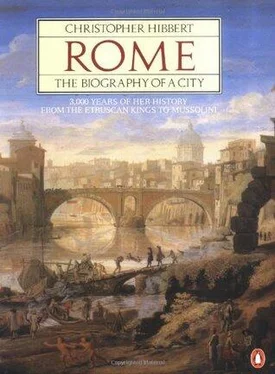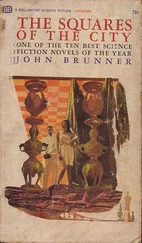Christopher Hibbert - Rome. The Biography of the City
Здесь есть возможность читать онлайн «Christopher Hibbert - Rome. The Biography of the City» весь текст электронной книги совершенно бесплатно (целиком полную версию без сокращений). В некоторых случаях можно слушать аудио, скачать через торрент в формате fb2 и присутствует краткое содержание. Жанр: Культурология, Искусство и Дизайн, на английском языке. Описание произведения, (предисловие) а так же отзывы посетителей доступны на портале библиотеки ЛибКат.
- Название:Rome. The Biography of the City
- Автор:
- Жанр:
- Год:неизвестен
- ISBN:нет данных
- Рейтинг книги:3 / 5. Голосов: 1
-
Избранное:Добавить в избранное
- Отзывы:
-
Ваша оценка:
- 60
- 1
- 2
- 3
- 4
- 5
Rome. The Biography of the City: краткое содержание, описание и аннотация
Предлагаем к чтению аннотацию, описание, краткое содержание или предисловие (зависит от того, что написал сам автор книги «Rome. The Biography of the City»). Если вы не нашли необходимую информацию о книге — напишите в комментариях, мы постараемся отыскать её.
Rome. The Biography of the City — читать онлайн бесплатно полную книгу (весь текст) целиком
Ниже представлен текст книги, разбитый по страницам. Система сохранения места последней прочитанной страницы, позволяет с удобством читать онлайн бесплатно книгу «Rome. The Biography of the City», без необходимости каждый раз заново искать на чём Вы остановились. Поставьте закладку, и сможете в любой момент перейти на страницу, на которой закончили чтение.
Интервал:
Закладка:
Christopher Hibbert
Rome
THE BIOGRAPHY OF A CITY
TO TOM AND ALLYCE
Christopher Hibbert was born in Leicestershire in 1924 and educated at Radley and Oriel College, Oxford. He served as an infantry officer during the war, was twice wounded and was awarded the Military Cross in 1945. Described in the New Statesman as ‘a pearl of biographers’, he is, in the words of The Times Educational Supplement, ‘perhaps the most gifted popular historian we have’. His many highly acclaimed books include the following titles, most of which are published by Penguin: The Destruction of Lord Raglan (which won the Heinemann Award for Literature in 1962); London: The Biography of a City; The Rise and Fall of the House of Medici; The Great Mutiny: India 1857; The French Revolution; Garibaldi and His Enemies; Rome: The Biography of a City; Elizabeth I: A Personal History of the Virgin Queen; Florence: The Biography of a City; Nelson: A Personal History; George III: A Personal History; and The Marlboroughs: John and Sarah Churchill 1650–1744.
Christopher Hibbert is a Fellow of the Royal Society of Literature and an Hon. D. Litt. of Leicester University. He is married with two sons and a daughter, and lives in Henley-on-Thames.
The frontispiece shows a detail of the Isola Tiberina by G. Vanvitelli (1653–1736) from the Musei Capitolini in Rome
AUTHOR'S NOTE
Although this book is intended to be an introduction to the history of Rome and of the social life of its people from the days of the Etruscan kings to those of Mussolini, I have tried at the same time to make it, in some sense, a guidebook. It cannot pretend to be a comprehensive one, but the notes at the back contain some information about all the buildings and treasures of the city which are mentioned in the text; and I believe that none of the principal sights and delights of Rome has been omitted. The book will, therefore, I hope, not only provide for the general reader an outline of Rome's varied past, as well as character sketches of those who have played their parts in its long history and development, but will also be of practical use to all those who intend one day to visit or revisit this most wonderful of cities.
The book could scarcely have been written without the help of my friend, the Hon. Edmund Howard, formerly Counsellor at the British Embassy in Rome, whose deep knowledge of the city and its people has guided me at every stage of its preparation. He has given me extensive assistance with the notes and, having read the manuscript, has made many suggestions for its improvement. Nor would working on the book have proved such a pleasure without the encouragement of another friend, John Guest, my skilful and trusted editor for over twenty-five years and my companion on numerous walks from one end of Rome to the other.
I am also deeply indebted to Tessa Street who has been both an impeccable typist and a careful reader of the text. And I am also most grateful to yet other friends who have helped me in a variety of ways, to my agent Bruce Hunter; to Peter Carson and Eleo Gordon of Viking; to Thomas Wallace of W.W. Norton; to Peter Hebblethwaite and Father Philip Caraman; to Ben Weinreb and the late Professor Roberto Weiss; to Maria Orsini and Thérèse Pollen; to Valerie Goodier and Nonie Rae, and to the libraries and staffs of the London Library and the Italian Institute of Culture. I am, as always, indebted to my wife for having compiled the comprehensive index.
PART ONE
ONE
MYTHS, MONARCHS AND REPUBLICANS
In the days of Augustus, the first of the Roman emperors, a young writer from Padua, Titus Livius, brought to a close the first part of his epic history of the city in which he had come to live. His story had begun in that remote age, seven hundred years before his own birth, in which the origins of Rome were overcast by the mists of romantic legend. Its scene was the high ground overlooking the Tiber some fifteen miles from the salt flats through which the river flowed to the sea. Down the slopes of the hills ran streams which formed swamps and small lakes in the valleys below. 1And beyond the valleys was the wide expanse of the Roman Campagna, a silent, undulating plain of woodland and pasture that stretched as far as the eye could reach to the surrounding mountains, to the Alban hills in the south, to the Apennines in the east, and, in the north, to the commanding heights of the empire of the Etruscans. Above a bend in the Tiber, where an island lay in midstream like an anchored ship, was the only place for miles at which the river could be crossed with ease. Here rose a hill which was to become known as the Palatine; and it was here, in the eighth century before Christ, that Titus Livius set his story.
He wrote of Romulus and Remus, twin sons of Rhea Silvia, daughter of Numitor, King of Alba Longa in the Alban Hills and a descendant of Aeneas, the hero of Troy. While a virgin attendant in a sacred shrine, Rhea Silvia had been raped by a man she claimed was Mars, god of war. Her twin babies had been left to die in a bucket by the waters of the flooded Tiber but had been saved by a she-wolf which had offered them her teats to suck and had nursed them gently until they were found by a herdsman who took them back to his hut. On reaching manhood, in 753 B.C. the twins decided to establish a new settlement for their tribe on the hills above the river where their lives had been saved; and they asked the gods of the countryside to declare by augury which of them should be its governor. Romulus then climbed to the top of the Palatine, while Remus took up his position on the summit of the nearby hill, the Aventine, to watch for signs in the flight of birds by which the gods made their wishes known. Soon six vultures flew across the Aventine, and Remus understood from this that his claims had been preferred. But then a flight of twelve vultures spread their wings above the Palatine, and Romulus took this as a sign that the gods' favours had fallen upon him. The brothers fell to quarrelling; their supporters began to fight each other; Remus jumped over the half-finished walls which his brother had built on the Palatine, and Romulus killed him in a fit of rage.
Thereafter Romulus's settlement grew and prospered. Yet, whereas there were strong and able men enough, there were too few women, the refugees from other tribes to whom asylum had been given at Rome, in the hope of increasing the population, being mostly male. Romulus, therefore, sent envoys to the surrounding peoples proposing intermarriage. But their offers were insultingly declined. To Romulus the use of force now seemed inevitable, and he set the scene of it with care and cunning. Concealing his resentment, he announced that the forthcoming celebrations of the Consualia, the festival Livy supposed was in honour of the water-deity Neptunus, would be held at Rome that year with particular splendour and that all surrounding tribes would be welcome to attend them. Among the peoples who accepted the invitation and came to inspect the walls and dwellings of the rapidly growing settlement were the Sabines, a well-favoured mountain tribe from the north. When the celebrations were at their height, the men of Rome fell upon the youngest of the Sabine women and dragged them to their homes, while their parents fled through the gates in panic-stricken terror. The fears of the Sabine girls were allayed by Romulus who assured them that as wives of Romans they would thereafter be treated well, sharing in the privileges of the new community and enjoying its coming greatness; they must overcome their present bitterness and give their hearts to those who had taken possession of their bodies.
Читать дальшеИнтервал:
Закладка:
Похожие книги на «Rome. The Biography of the City»
Представляем Вашему вниманию похожие книги на «Rome. The Biography of the City» списком для выбора. Мы отобрали схожую по названию и смыслу литературу в надежде предоставить читателям больше вариантов отыскать новые, интересные, ещё непрочитанные произведения.
Обсуждение, отзывы о книге «Rome. The Biography of the City» и просто собственные мнения читателей. Оставьте ваши комментарии, напишите, что Вы думаете о произведении, его смысле или главных героях. Укажите что конкретно понравилось, а что нет, и почему Вы так считаете.












